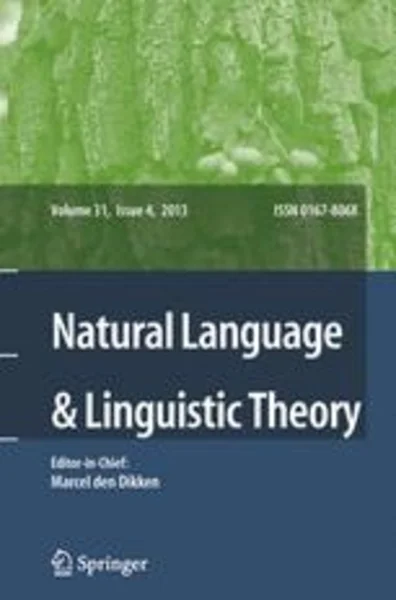-
deconstructing switch-reference
جزئیات بیشتر مقاله- تاریخ ارائه: 1392/03/01
- تاریخ انتشار در تی پی بین: 1392/03/01
- تعداد بازدید: 327
- تعداد پرسش و پاسخ ها: 0
- شماره تماس دبیرخانه رویداد: -
this paper develops a new view on switch-reference, a phenomenon commonly taken to involve a morphological marker on a verb indicating whether the subject of this verb is coreferent with or disjoint from the subject of another verb. i propose a new structural source of switch-reference marking, which centers around coordination at different heights of the clausal structure, coupled with distinct morphological realizations of the syntactic coordination head. conjunction of two vps has two independent consequences: first, only a single external argument is projected; second, the coordinator head is realized by some marker a (the ‘same subject’ marker). conjunction of two vps, by contrast, leads to projection of two independent external arguments and a different realization of the coordination by a marker b (the ‘different subject’ marker). the hallmark properties of this analysis are that (i) subject identity or disjointness is only indirectly tied to the switch-reference markers, furnishing a straightforward account of cases where this correlation breaks down; (ii) switch-reference does not operate across fully developed clauses, which accounts for the widely observed featural defectiveness of switch-reference clauses; (iii) ‘same subject’ and ‘different subject’ constructions differ in their syntactic structure, thus accommodating cases where the choice of the switch-reference markers has an impact on event structure. the analysis is mainly developed on the basis of evidence from the mexican language seri, the papuan language amele, and the north-american language kiowa.
مقالات جدیدترین رویدادها
-
استفاده از تحلیل اهمیت-عملکرد در ارائه الگوی مدیریت خلاقیت سازمانی و ارائه راهکار جهت بهبود
-
بررسی تاثیر ارزش وجوه نقد مازاد بر ساختار سرمایه شرکت های پذیرفته شده در بورس اوراق بهادار تهران
-
بررسی تأثیر سطح افشای ریسک بر قرارداد بدهی شرکت های پذیرفته شده در بورس اوراق بهادار تهران
-
بررسی تأثیر رتبه بندی اعتباری مبتنی بر مدل امتیاز بازار نوظهور بر نقد شوندگی سهام با تأکید بر خصوصی سازی شرکت ها
-
تأثیر آمیخته بازاریابی پوشاک ایرانی بر تصویر ذهنی مشتری پوشاک ایرانی (هاکوپیان)
-
اثر میراگر ویسکوز بر عملکرد لرزه ای ساختمان های بلندمرتبه فولادی با سیستم هسته و مهاربازویی
-
طبقه بندی طیفی – مکانی تصاویر ابرطیفی با تخمین توزیع احتمال پسین مبتنی بر کرنل، میدان های تصادفی مارکوف و یادگیری فعال پیوندهای شکننده اصلاح شده
-
تایید نتایج تجربی تراکم دینامیکی توسط غلتک ضربه ای مربعی شکل روی خاکها با استفاده از مدل کردن با نرم افزار "abaqus" و ارزیابی عمق تاثیر در خاکهای تحت تراکم آن
-
اثربخشی راهبردهای خود تنظیمی و خود کنترلی در بهبود اختلال املاء نویسی دانش آموزان پسر اول ابتدایی شهرستان بجنورد
-
معرفی قارچ دارویی دنبلان و امکان سنجی کشت مصنوعی آن
مقالات جدیدترین ژورنال ها
-
مدیریت و بررسی افسردگی دانش آموزان دختر مقطع متوسطه دوم در دروان کرونا در شهرستان دزفول
-
مدیریت و بررسی خرد سیاسی در اندیشه ی فردوسی در ادب ایران
-
واکاوی و مدیریت توصیفی قلمدان(جاکلیدی)ضریح در موزه آستان قدس رضوی
-
بررسی تاثیر خلاقیت، دانش و انگیزه کارکنان بر پیشنهادات نوآورانه کارکنان ( مورد مطالعه: هتل های 3 و 4 ستاره استان کرمان)
-
بررسی تاثیر کیفیت سیستم های اطلاعاتی بر تصمیم گیری موفق در شرکتهای تولیدی استان اصفهان (مورد مطالعه: مدیران شرکتهای تولیدی استان اصفهان)
-
اثربخشی بازی درمانی فلورتایم بر بهبود تنظیم شناختیِ هیجان کودکان مبتلا به اختلال نارسایی توجه/ بیش فعالی (adhd)
-
تحلیل ماهیت حقوقی مشارکت تجارتی (جوینت ونچر) در عرصه بین الملل joint venture
-
بررسی تأثیر نگرش به تبلیغات و برند بر قصد خرید از تبلیغات گوشی های هوشمند
-
نقش علم وایمان در درمان بیماری ها (نگاهی کوتاه به بیماری قرن، کرونا)
-
بررسـی روند تجلی مضامین شیعی در نگارگری ایران




سوال خود را در مورد این مقاله مطرح نمایید :